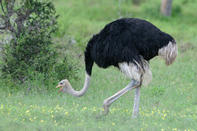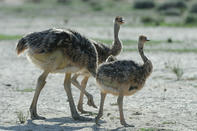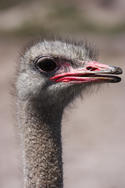Largest, Heaviest and Old

Ostriches are the largest and heaviest living birds in the world standing two and a half metres tall and weighing in at 150 kg (large males). They are also extremely long-lived surviving in the wild for about 40 years.
Ostriches are flightless. They do not possess a keeled breastbone necessary for the attachment of flight muscles. They also have soft, loose feathers that can’t be zipped together for streamlining by means of barbules like other birds’ feathers. For this reason, they lack a preen gland.
Flightless birds are called ‘ratites’ which is the Latin word for ‘raft’ referring to their flat breastbones. In spite of being flightless, ostriches do still have very strong wings, which are used in aggressive displays and courtship displays.
Two Toes

The ostrich is the only bird to have only two toes on each foot. This seems to be a useful adaptation as ostriches are the fastest running birds reaching speeds of 70 kmph. Ostriches run as a first instinct to escape danger, which may come in the form of lions, hyenas or cheetah.
They can cover 5 -7 metres per stride and maintain a constant speed for half an hour on the trot. They can also deliver a powerful kick to defend themselves, the blow measuring 500 pounds per square inch.
Jumping and flailing of the wings are common in frightened birds and this in itself may cause injury to threatening predators. Ostriches have an unusual call. The male makes a deep booming sound that may be confused with the distant call of lions.
Big Eyes

The ostrich has the largest eyeballs of all birds being 5 cm wide. Relative to its skull, the eyes are simply enormous and comparable to the size of the eyes found in large mammals with significantly larger heads. Large eyes afford the ostrich excellent vision as more image falls on the retina and so a greater amount of detail can be perceived.